 The Tale of Lady Thị Kính by P.Q. Phan will be premiered at Indiana University Jacobs School of Music in 2014. It is difficult for me to explain to the Vietnamese community in America why the first opera by a Vietnamese American composer featuring a popular Vietnamese folktale is produced in Bloomington, IN, where there are only a handful of Vietnamese Americans. They would not believe the reasons I will give them, until they come and see for themselves. But I just have to try to paint a picture for them.
The Tale of Lady Thị Kính by P.Q. Phan will be premiered at Indiana University Jacobs School of Music in 2014. It is difficult for me to explain to the Vietnamese community in America why the first opera by a Vietnamese American composer featuring a popular Vietnamese folktale is produced in Bloomington, IN, where there are only a handful of Vietnamese Americans. They would not believe the reasons I will give them, until they come and see for themselves. But I just have to try to paint a picture for them.
Once upon a time, Indiana University Bloomington was a safe haven for scholars from foreign countries overrun by the Nazi German. It is not difficult to imagine that they found peace here as Bloomington is nestled in the woods and hills. As a result of IU President Herman B Wells’s ardent advocacy for the preservation of trees and green space on campus, IU Bloomington is often considered the top five most beautiful campuses in the country.
Located in the Midwest, Bloomington is woods and lakes away from both the Pacific and Atlantic oceans. It is not bustling as New York or LA. There are no phở restaurant or bánh mì (Vietnamese sandwich) shops in Bloomington, either. Hills after hills, woods after woods, lakes after lakes, and serenity are what we have here in Bloomington. In the Winter, the bare tree-woods are silvery with snow; and in the Summer, they are lusty with greens – so much so that if one is driving on the neat city roads one feels like wading in the boxwood labyrinth paths. It is by no means an overstatement that Bloomington is a haven in the woods on top of the hills.
The opera program at IU School of Music began to flourish in the 1940s. Even before the establishment of IU Opera Theater in 1972 as a separate entity dedicated to creating the best performance environment for music students, the opera production at IU Bloomington already caught national attention. These days, one of the attractions of IU Jacobs School of Music to music students all over the country and around the world is the opera productions by IU Opera Theater. During the school year, Bloomington is especially busy with musical activities – recitals, chamber orchestra concerts, symphony orchestra concerts, among tons of others. Most inspiring of all for serious music lovers is the opera program. The opera performances draw young and professional and senior audience alike to IU Opera Theater, at the Musical Arts Center (MAC).
On opera nights, MAC Theater could be described as a “Clean, Well-Lighted Place” where people hustle around like birds busily building their nests in Spring. In front of the Theater are giant buses that have picked up the seniors from retirement communities now dropping them off. And who gets off the bus but ladies and gentlemen in the best outfits for their opera night. Whether with or without walkers, they are chatting their way into the Theater Hall, their faces beaming, like children again. Student couples and groups are in no way behind. In order to compete with their peers, they don their most hip jackets and dresses. I often notice music students and professors to be making the finest fashion statements. Other professionals are the middle group between students and seniors. Being daunting rivals as they are, they also take the opportunity to dress up with clothes and jewelry they have put aside for special occasions.
Together, they are trotting along the curving paths outside the Theater and the Hall inside like strolling around an art festival. Knowingly, to express their belief in what opera going is supposed to be, or unknowingly, they revive opera going to the way it originally was – a pleasure in lavishness and a vibrant social setting. It is very pleasant to watch them all – the people and the place. A visitor from the East or West coast will observe with amazement at how calm and joyous opera goers are in Bloomington. There is void of scenes where people complain about the stress of being stuck in the traffic somewhere, or scenes where they rush out of the theater right before the standing ovation to hit the road before everyone else does. It only takes fifteen minutes or so to crew around Bloomington. The night is long, why worry!
At some point, the whole picture of Bloomington-opera-festival seems frozen in time. Opera goers merge into the glittering atmosphere of lights and colorful billboard-sized posters and people-talking-and-laughing; then merge one more time into the performance on stage, leaving time behind. For young people and professionals, this spiritual experience is an effective way to de-stress that they really appreciate. For seniors whose lines of activities and time are insidiously slipping into oblivion, this very opera-time is a wakening chime that accompanies them in an exciting short stroll with the opera festival. They will later get on the bus to return to their everyday reality, and wait to be woken again at the next opera-festival-time.
If people’s thoughts are often masked by noises of activities for the sake of doing and living, people have a real chance to clear their mind in Bloomington to enjoy opera in a special way. Bloomington opera festival is full of colors and sounds, yet calm and quiet enough for people to hear their voice and to hear even their thoughts. This “Bloomington” special effect is particularly appropriate for the enjoyment of The Tale of Lady Thị Kính whose universal elements regarding human struggles to make sense of life transpose time. The story itself also transposes space to allow the audience a niche – to ponder on human life and beyond.
In terms of a conclusion for the Vietnamese American audience, IU Opera Theater is among the best opera companies in America with its unmatched professional performances. Its world premiers are reviewed by experts in the field. Therefore, it goes without saying that not only does the staging of The Tale of Lady Thị Kính by IU Opera Theater bring honor to its composer, but its production also provides pride to the Vietnamese community in the United States. The audience should have all the reasons to look forward to its premier.
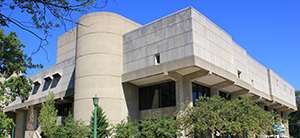 By now, if you are not convinced that Bloomington is an especially lovely town and IU Opera Theater a unique institution, then I have not done enough. So here is some more.
By now, if you are not convinced that Bloomington is an especially lovely town and IU Opera Theater a unique institution, then I have not done enough. So here is some more.
If you want to walk or drive 15 minutes to work and then go home on the non-traffic roads to spend some time with your family before dinner, then you’ll love Bloomington – five minutes in traffic jam is already a big deal in Bloomington. If you want to drive 10-15 minutes to reach a decent, or a very good, Thai, Mexican, Indian, Mongolian, Turkish, Afghanistan, Tibetan or Japanese restaurant then you’ll love Bloomington even more. If at 80 you still drive and are spared the pain of being honked at for driving too slowly, then you’ll adore Bloomington – on Bloomington roads, it is “Seniority over Beauty!”
That is Bloomington – convenient, quiet, and safe – a gem the locals would prefer to keep that way. And why not. Without the traffic, noise and pollution of a big city, Bloomington is indeed “bombarded” with free cultural and musical activities. What is available on a given day as entertainments in one form or another is more than what anyone can physically and mentally handle. There are choices of lectures, art exhibitions, plays, musicals, jazz concerts, Broadway shows, chamber music concerts, or operas, etc. These events are only fifteen minutes away from wherever you are in Bloomington, all year round. Did I mention most of them are free?
Located in the Midwest, IU Bloomington used to be known as a safe haven from all the East and West coasts commotions around the time of WWII and the Cold War, and IU opera production started being known nationally since the 1960s. Gone are those times, and so are those who knew IU opera. Now is the time for big cities. Without this advantage, IU Opera has to spread the word anew.
For people from the Vietnamese American communities, the news is that in 2014 IU Opera Theater will produce The Tale of Lady Thị Kính, the first opera ever by a Vietnamese American composer. For those who don’t know what IU Opera can do and has to offer, statistics is a good start.
Right off the official website: Full productions by IU Opera Theater are presented under the roof of the Musical Arts Center (MAC) and four orchestras accompany the works. As one of the grandest performance venues in the United States, the MAC seats 1,460. It features acoustical design and technical capabilities that are among the best in the United States. Regularly compared to the Metropolitan Opera in New York City, the main stage is 90 feet wide by 60 feet deep. The backstage area occupies more than half the building and provides a state-of-the art theater space for technical work. All eyes should now be on the production by IU Opera Theater.
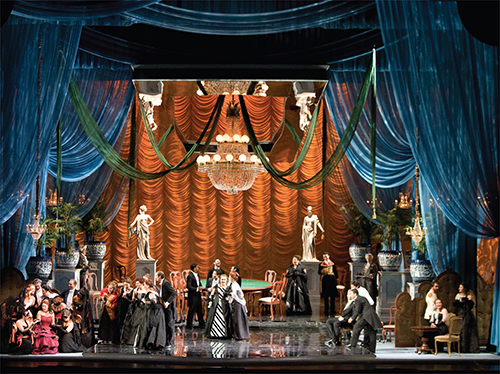
Definitely a big operation, much bigger than most regional companies that do three operas a year, yet IU Opera Theater is understaffed. Opera companies such as Cincinnati, Saint Louis, or Atlanta have three or four times the staff of IU Opera Theater – basically one professional department head and then students for each department. An outside professional would often be surprised at its production scale. This speaks volume to the fact that not only do IU Opera Theater get by with their outstanding students who can do wonders in a right environment, but they are able to maintain a 150-200 thousand dollar average budget for an opera. (This amount does not include the commission for a new opera.) “The most expensive opera was about 260,” Mr. Tim Stebbins, Executive Director of Production for IU Opera Theater, recalled, “but in the outside world, that opera probably would have cost a million or more. We get by because there is no union labor, and the average rate we pay students is not what you would find in the professional world.”
Not to let those numbers fool you seems to be a fair warning since IU Opera productions can wow any audience. Modeling after the professional opera industry, IU Opera Theater serves as a learning laboratory for vocalists and instrumentalists of IU Jacobs School of Music. With their superb facilities, world-renowned faculties, and talented students IU Opera Theater productions are comparable to the MET’s, for many of the things that the MET do in their productions, they do the same thing here. “The MET might spend a million dollars just on lighting design,” said Mr. Stebbins, “so they are able to do more magical things technically. That I think really is where the difference is, besides the singers, of course.” But in terms of just producing traditional scenery and being able to run a big scale production, Mr. Stebbins is confident that IU Opera Theater “is probably right in line with what the MET or other professional company is doing.”
On the list of the wow team notables are the recent retiree and great designer David Higgins who has been with IU Opera Theater for so long; Robert O’Hearn who had a big career at the MET and then was here at IU Opera Theater for nearly twenty years. Next year, Dough Fitch who just did “The Cunning Little Vixen” with the New York Philharmonic and Robert Perdziola who is top of the line as a designer will join the team. Mr. Stebbins is working hard to make sure that the personnel in those professional positions in designing, conducting and directing are “the same that you’re going to see working with the MET or the Chicago Lyrics, etc.” So in a way, it makes sense, “they design for them, they design for us,” Mr. Stebbins said. “We just get it done differently, with much less staff, with our students, and that is an amazing thing.”
Now to let the numbers wow you seems to be the fair thing: IU Opera’s six full scale productions a year is an achievement that only a few opera companies are able to make; three of them, brand new, being further kudos even more difficult for any to keep up with. This will be the same working environment when IU Opera Theater is staging The Tale of Lady Thị Kính by PQ Phan in 2014. This opera is an invitation to the Vietnamese American community to venture more into arts fields, and to the American audience to rediscover “Việt Nam” from a new perspective and on a new level, exploring an alien work of art of huge universal humane significance.
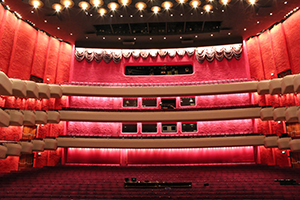 There are things you just have to see with your own eyes to get the real sense of it. The Musical Arts Center (MAC) in Bloomington is a case in point. The tour of the MAC opens a door into a behind-the-scenes world that gives you a glimpse into some “mysterious” aspects involved in the production of an opera.
There are things you just have to see with your own eyes to get the real sense of it. The Musical Arts Center (MAC) in Bloomington is a case in point. The tour of the MAC opens a door into a behind-the-scenes world that gives you a glimpse into some “mysterious” aspects involved in the production of an opera.
IU Opera Theater is housed under the roof of the MAC. The tour of the MAC starts at the public area, the hall, where people come when they go to a concert or an opera. Steeping foot inside, one already feels the sense of calm and relaxation as nobody is carrying the go-getting attitude here for anything. This is the space for you to calm yourself down and get ready to enjoy the show. The environment is designed to bring you closer to this state of mind as well. The open space in the big hall with no objects in the way to obstruct the view is a great treat for the eyes and also for the mind. The one-of-a-kind carpet pattern sets you up for the artistic atmosphere of the theater paving the way for the coming performance on stage.
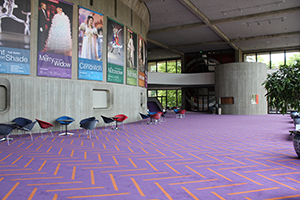 As your stress is down and your calm is up, you are ready to enter the house (e.g. audience space.) With the seating capacity of 1,460 the MAC is big enough to mesmerize opera lovers with the wonders it can offer on stage. As for the first time opera goers, they will be amazed. Yet the theater is not too big to intimidate them.
As your stress is down and your calm is up, you are ready to enter the house (e.g. audience space.) With the seating capacity of 1,460 the MAC is big enough to mesmerize opera lovers with the wonders it can offer on stage. As for the first time opera goers, they will be amazed. Yet the theater is not too big to intimidate them.
“Acoustic of the MAC is optimized for opera,” Mr. Tridib Pal, Marketing Outreach and House Manager of IU Opera Theater, will let you know along the tour. Instead of wood paneling, the walls inside the MAC has some texture on them which helps to change the sound a little so it doesn’t ring as much which in turn helps with understanding the text and the voice better. The MAC is very tall, taller than most opera houses, but not very deep – a feature especially favorable to students in the twenties whose voices are not mature as those professionals in the thirties, and who benefit from performing in a hall with this different design. Their voices can carry easily making them feel “they are singing into a large house without pushing their voice to the point they do damage to it,” Mr. Pal explained. “That is why MAC acoustic is considered one of the best in the country.”
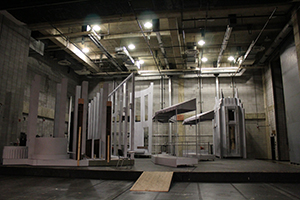 The design inside the theater is typical of European opera houses with no internal isles. The colors of the MAC are original as chosen by the architect who built it more than 40 years ago. The nontraditional pallet of orange, pink and purple creates a very modern and lively environment as you walk into the hall.
The design inside the theater is typical of European opera houses with no internal isles. The colors of the MAC are original as chosen by the architect who built it more than 40 years ago. The nontraditional pallet of orange, pink and purple creates a very modern and lively environment as you walk into the hall.
Step on the performance stage facing the audience, and you are at the center of the universe: fifteen hundred people on red cloth seats in front of you, bright light over your head and all over you, the performance stage being surrounded by a myriad of lighting, audio and staging equipment managed by technicians who can easily fly you across the stage or create snow or build a lavish banquet scene. This central spot on stage is the action center of a kaleidoscope of light, sound, spectacle, spectators, singers, actors, technicians – all commingling to deliver a sense of multi dimensions that you can really feel.
With your back to the audience, however, you discover a same-different world. Looking down to your feet, the wooden floor with rectangular sections are fully trapped so that a person can be dropped down anywhere on the floor if need to and a villain can be sent to hell with ease. Looking up, you don’t see the ceiling. Instead there is a matrix of cords and bars and boards and an abyss of things you cannot name because it is too high and too dark up there to see. Mr. Pal said “the ceiling height is ten stories. Most of it is flag space.”
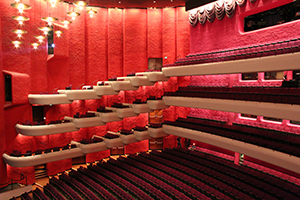 Still with your back to the audience, look around to feel the sense of space. The main stage is 90 feet wide by 60 feet deep. Straight ahead on the rear, on the left and on right are three different platforms. They are all wagons, they are all on wheels, and they are all on tracks. If need to, Mr. Pal continued, “we can hook the wagons together so the entire wagon can move out, or we can disconnect and move a part of them.” The whole wagon is the same size of the performance stage. Could you imagine how the stage moves and turns around during a performance now? Then, try to catch this: Depending on the schedule, the platforms can become space to prepare the setting for more than one opera at the same time. Each platform has soundproof panels that can come down and close off, as Mr. Pal narrated, so that they can actually have a performance going on on the main stage while working on some other rehearsal behind it. How genius!
Still with your back to the audience, look around to feel the sense of space. The main stage is 90 feet wide by 60 feet deep. Straight ahead on the rear, on the left and on right are three different platforms. They are all wagons, they are all on wheels, and they are all on tracks. If need to, Mr. Pal continued, “we can hook the wagons together so the entire wagon can move out, or we can disconnect and move a part of them.” The whole wagon is the same size of the performance stage. Could you imagine how the stage moves and turns around during a performance now? Then, try to catch this: Depending on the schedule, the platforms can become space to prepare the setting for more than one opera at the same time. Each platform has soundproof panels that can come down and close off, as Mr. Pal narrated, so that they can actually have a performance going on on the main stage while working on some other rehearsal behind it. How genius!
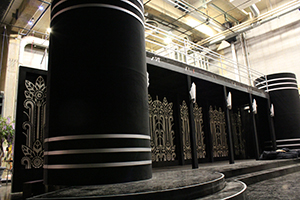 Now you understand why people often say that the part of the stage that you see during a performance is only about one third of the real size of the whole stage. The backstage area does occupy more than half the building and provides a state-of-the art theater space for technical work. Many Jacobs School of Music students don’t realize that this facility is very unusual to have at a university. Mr. Pal said that he often reminds the students not to get too spoiled and take for granted the magnitude of the program and facility here. Their first job singing with a professional orchestra may not come with access to this kind of stage.
Now you understand why people often say that the part of the stage that you see during a performance is only about one third of the real size of the whole stage. The backstage area does occupy more than half the building and provides a state-of-the art theater space for technical work. Many Jacobs School of Music students don’t realize that this facility is very unusual to have at a university. Mr. Pal said that he often reminds the students not to get too spoiled and take for granted the magnitude of the program and facility here. Their first job singing with a professional orchestra may not come with access to this kind of stage.
At the end of the tour, one cannot help feeling a sense of luxury, luxury of materials – real wood, real paint, real cloths, real curtains; luxury of space – big and small, dark and bright, round and rectangular, thin and thick. But wait, all is for free. Just register in advance, then come join the tour for an incredible experience!
UNDER CONSTRUCTION
© 2013 P.Q. Phan